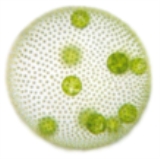
Volvox
Overview
Volvox is a genus of chlorophytes, a type of green algae
. It forms spherical colonies
of up to 50,000 cells. They live in a variety of freshwater
habitats, and were first reported by Antonie van Leeuwenhoek in 1700. Volvox developed its colonial lifestyle .
Volvox is the most developed in a series of genera that form spherical colonies. Each mature Volvox colony
is composed of numerous flagellate
cells similar to Chlamydomonas
, up to 50,000 in total, and embedded in the surface of a hollow sphere or coenobium
containing an extracellular matrix
made of a gelatinous glycoprotein
.
Green algae
The green algae are the large group of algae from which the embryophytes emerged. As such, they form a paraphyletic group, although the group including both green algae and embryophytes is monophyletic...
. It forms spherical colonies
Colony (biology)
In biology, a colony reference to several individual organisms of the same species living closely together, usually for mutual benefit, such as stronger defense or the ability to attack bigger prey. Some insects live only in colonies...
of up to 50,000 cells. They live in a variety of freshwater
Freshwater
Fresh water is naturally occurring water on the Earth's surface in ice sheets, ice caps, glaciers, bogs, ponds, lakes, rivers and streams, and underground as groundwater in aquifers and underground streams. Fresh water is generally characterized by having low concentrations of dissolved salts and...
habitats, and were first reported by Antonie van Leeuwenhoek in 1700. Volvox developed its colonial lifestyle .
Volvox is the most developed in a series of genera that form spherical colonies. Each mature Volvox colony
Colony (biology)
In biology, a colony reference to several individual organisms of the same species living closely together, usually for mutual benefit, such as stronger defense or the ability to attack bigger prey. Some insects live only in colonies...
is composed of numerous flagellate
Flagellate
Flagellates are organisms with one or more whip-like organelles called flagella. Some cells in animals may be flagellate, for instance the spermatozoa of most phyla. Flowering plants do not produce flagellate cells, but ferns, mosses, green algae, some gymnosperms and other closely related plants...
cells similar to Chlamydomonas
Chlamydomonas
Chlamydomonas is a genus of green algae. They are unicellular flagellates. Chlamydomonas is used as a model organism for molecular biology, especially studies of flagellar motility and chloroplast dynamics, biogenesis, and genetics...
, up to 50,000 in total, and embedded in the surface of a hollow sphere or coenobium
Coenobium
A coenobium is a colony containing a fixed number of cells, with little or no specialization. They occur in several groups of algae. The cells are often embedded in a mucilaginous matrix and may be motile or non-motile....
containing an extracellular matrix
Extracellular matrix
In biology, the extracellular matrix is the extracellular part of animal tissue that usually provides structural support to the animal cells in addition to performing various other important functions. The extracellular matrix is the defining feature of connective tissue in animals.Extracellular...
made of a gelatinous glycoprotein
Glycoprotein
Glycoproteins are proteins that contain oligosaccharide chains covalently attached to polypeptide side-chains. The carbohydrate is attached to the protein in a cotranslational or posttranslational modification. This process is known as glycosylation. In proteins that have segments extending...
.
Unanswered Questions
Discussions

